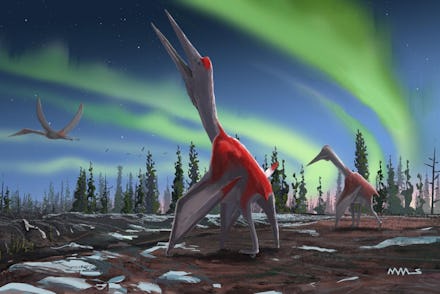This newly identified prehistoric reptile sounds like a ‘Game of Thrones’ creation

Once upon a time, there was a giant, flying reptile that lived in the north. It was a creature that was intimidating in size but possessed a skewed anatomy that was mostly head and neck. Although it had a 30 foot wingspan that it could use to soar the skies, it often lumbered on the ground to hunt instead. They called it Cryodradon boreas — the 'Frozen Dragon' of the North.
It might sound like a fantasy, but it's actually paleontology. A team of scientists from the University of Southern California have finally given name to the partial skeleton they've been able to put together over the past 30 years. The researchers had first thought the bones belonged to another, related, species of giant pterosaur, which led them astray for a long time.
According to National Geographic, scientists consider this aerial dinosaur another member of the azhdarchid family. This group of pterosaurs are known amongst researchers for their characteristic huge heads and necks. Based on their bone structure, scientists have hypothesized that these giraffe-sized beasts preferred to walk around on the ground to search for their food. Flight could have been used as a means to escape danger.
The continuing study of these pterosaurs is expanding our knowledge of how these giants lived on the Earth, what the ancient planet was like, and how diverse their species were. One of the study's co-authors, Michael Habib, describes them as "inspiration for countless movie monsters" and believe they were "critical parts of global ecosystems worldwide during the Age of Dinosaurs."
"[T]hey are key to understanding the ecology and extinctions of that time," Habib said in a statement to AAAS. "[J]ust like flying animals today, they could carry important clues about how animals at the time responded to major changes in climate."
If the name of the pterosaur sounds a bit Game of Thrones-like, then you're right. It was probably done on purpose. In fact, Habib is also a fan of the show; he had suggested they call the creature Cryodrakon viserion, after the series' ice dragon. There are distinct differences between the ice dragon and this pterosaur, however.
"The animal, when alive, would not have been a frozen dragon," Habib said in a comment to National Geographic. "It would have flying in a landscape that would have been reasonably temperate ... but a hell of a lot warmer than central Alberta is now."
Habib and his team's study can be found in the Journal of Vertebrate Paleontology. They currently plan to continue their analysis of the Cryodrakon's bones to theorize how, exactly, the frozen dragon flew.